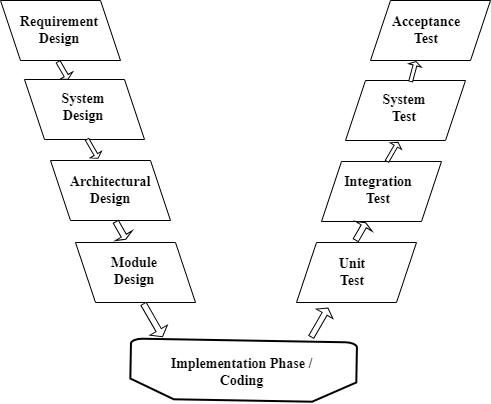
Verification and Validation Model or V-Model

The Verification and Validation Model, also known as the V-Model, is a software development and testing process model that emphasizes the relationship between the various phases of development and testing. It is an extension of the Waterfall model and is often used in the context of software testing and quality assurance. The V-Model is structured in a way that testing activities are closely aligned with development phases.
Verification and Validation are two processes that are essential to ensure that a software product meets its requirements and functions correctly.
Here’s an overview of each:
- Verification: Verification is the process of evaluating the software to determine whether it conforms to the specified requirements at various stages of development. This process is concerned with the “Are we building the product right?” question. Key activities in the verification process include:
- Reviews and Inspections: These are systematic examinations of software documents and code to identify defects and ensure compliance with requirements.
- Static Analysis: Analyzing software without executing it, often using tools to find potential issues.
- Walkthroughs: A detailed review of software design or code with the objective of identifying problems or issues.
- Documentation Verification: Ensuring that the software documentation, including specifications, design documents, and user manuals, is consistent and complete.
- Validation: Validation, on the other hand, is the process of evaluating the software to determine whether it meets the customer’s needs and expectations. This process is concerned with the “Are we building the right product?” question. Key activities in the validation process include:
- Dynamic Testing: Testing the software through its execution. This can include various types of testing, such as unit testing, integration testing, system testing, and user acceptance testing.
- Usability Testing: Evaluating the software from a user’s perspective to ensure that it is easy to use and meets user requirements.
- Functional Testing: Ensuring that the software performs its intended functions according to the requirements.
- Performance Testing: Assessing how well the software performs under different conditions, such as load testing, stress testing, and scalability testing.
- Security Testing: Identifying vulnerabilities and ensuring the software is secure against potential threats.
Here’s a simplified explanation of the V-Model and its key components:
- Requirements Phase: This is the initial phase where system and software requirements are gathered and documented. It is during this phase that the project requirements are clearly defined.
- System Design Phase: In this phase, the high-level system design is created based on the requirements. It outlines the architecture and major components of the system.
- Architectural Design: This is a more detailed design phase where the software architecture is defined, including how different components will interact with one another.
- Module Design Phase: This phase involves designing individual modules or components of the software system.
- Implementation Phase: This is where the actual coding of the software takes place. Developers write the code based on the designs created in the previous phases.
- Unit Testing: After the implementation of a module or component, unit testing is performed to ensure that each unit or piece of code works as expected.
- Integration Testing: Integration testing is performed to validate that different modules or components work together as intended when integrated into the complete system.
- System Testing: System testing involves testing the entire software system as a whole. It ensures that the complete system meets the specified requirements.
- Acceptance Testing: In this phase, the software is tested to determine if it meets the acceptance criteria defined by the customer or end-users. This is often the final phase of testing before the software is deployed.
The key feature of the V-Model is the clear and structured relationship between each development phase and its corresponding testing phase. For each phase of development, there is a corresponding phase of testing. This approach emphasizes the importance of early testing and validation, reducing the chances of discovering critical issues late in the development process.
The V&V model is a systematic approach that integrates both verification and validation processes to ensure that software development is on track and that the final product meets the desired quality and functionality. It helps in early defect detection and reducing the chances of delivering a product that does not meet the user’s needs. Various software development life cycle models, such as the Waterfall model, Agile, and V-Model, incorporate V&V principles to manage the software development and testing processes effectively.






Leave a Reply